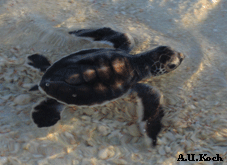Green sea
turtles
Status: Endangered
 Green turtles are distributed
worldwide, nesting on sandy beaches
Green turtles are distributed
worldwide, nesting on sandy beaches
The carapace of green turtles ranges
from olive brown to black. The name of the
green sea turtle derives from the colour of
their fat rather than any external
characteristics. Adult females have a curved
carapace length of 107cm and can weigh over
150kg.
 Green turtles feed
almost exclusively on sea grass when it's
available, and alternatively feed on sea weeds
and algae. Green turtles feed
almost exclusively on sea grass when it's
available, and alternatively feed on sea weeds
and algae.
The green turtle is the turtle that
is most favoured for eating. This was a common
practice in historical times but is less
common now with the protection of turtles
under international legislations.
|

 Green turtles are distributed
worldwide, nesting on sandy beaches
Green turtles are distributed
worldwide, nesting on sandy beaches Green turtles feed
almost exclusively on sea grass when it's
available, and alternatively feed on sea weeds
and algae.
Green turtles feed
almost exclusively on sea grass when it's
available, and alternatively feed on sea weeds
and algae.  An
excellent reference on sea turtle ecology is
presented in "Sea Turtles: An Ecological Guide" by
David Culko and Karen Eckert (2003). To purchase
this book please look at our
An
excellent reference on sea turtle ecology is
presented in "Sea Turtles: An Ecological Guide" by
David Culko and Karen Eckert (2003). To purchase
this book please look at our 